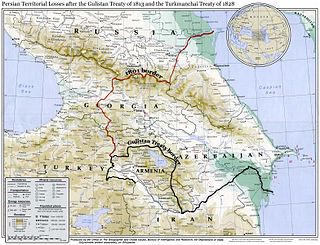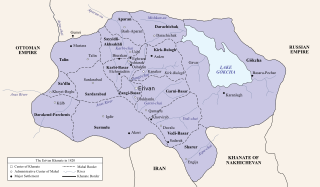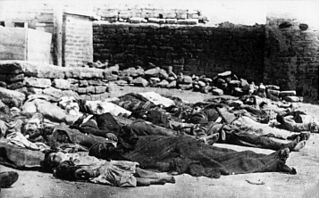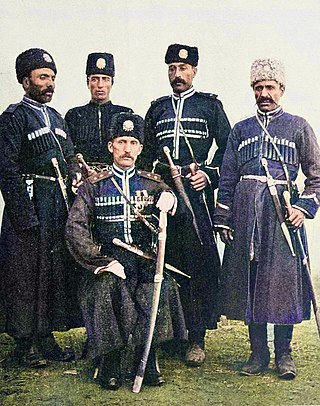
The South Caucasus, also known as Transcaucasia or the Transcaucasus, is a geographical region on the border of Eastern Europe and West Asia, straddling the southern Caucasus Mountains. The South Caucasus roughly corresponds to modern Armenia, Georgia, and Azerbaijan, which are sometimes collectively known as the Caucasian States. The total area of these countries measures about 186,100 square kilometres. The South Caucasus and the North Caucasus together comprise the larger Caucasus geographical region that divides Eurasia.

Azerbaijanis, Azeris, or Azerbaijani Turks are a Turkic ethnic group living mainly in the Azerbaijan region of northwestern Iran and the Republic of Azerbaijan. They are predominantly Shia Muslims. They comprise the largest ethnic group in the Republic of Azerbaijan and the second-largest ethnic group in neighboring Iran and Georgia. They speak the Azerbaijani language, belonging to the Oghuz branch of the Turkic languages.

Mahammad Amin Akhund Haji Molla Alakbar oghlu Rasulzade was an Azerbaijani politician, journalist and the head of the Azerbaijani National Council. He is mainly considered the founder of Azerbaijan Democratic Republic in 1918 and the father of its statehood. His expression "Bir kərə yüksələn bayraq, bir daha enməz!" became the motto of the independence movement in Azerbaijan in the early 20th century.

Arran, also known as Aran or Ardan, was a geographical name used in ancient and medieval times to signify a historically-Iranian region which lay within the triangle of land, lowland in the east and mountainous in the west, formed by the junction of the Kura and Aras rivers, including the highland and lowland Karabakh, Mil plain and parts of the Mughan plain. In pre-Islamic times, it corresponded roughly to the territory of the modern-day Republic of Azerbaijan. The term is the Middle Persian equivalent to the Greco-Roman Albania. It was known as Aghvania, Alvan-k in Armenian, and Al-ran in Arabic.

The Treaty of Gulistan was a peace treaty concluded between the Russian Empire and Qajar Iran on 24 October 1813 in the village of Gulistan as a result of the first full-scale Russo-Persian War. The peace negotiations were precipitated by the successful storming of Lankaran by General Pyotr Kotlyarevsky on 1 January 1813. It was the first of a series of treaties signed between Qajar Iran and Imperial Russia that forced Persia to cede the territories that formerly were part of Iran.

The Müsavat Party is the oldest existing political party in Azerbaijan. Its history can be divided into three periods: Early Musavat, Musavat-in-exile and New Musavat.
The culture of Azerbaijan combines a diverse and heterogeneous set of elements which developed under the influence of Iranic, Turkic and Caucasian cultures. Azerbaijani culture includes its cuisine, literature, folk art, and music.

The Azerbaijan Democratic Republic, also known as the Azerbaijan People's Republic, was the first secular democratic republic in the Turkic and Muslim worlds. The ADR was founded by the Azerbaijani National Council in Tiflis on 28 May 1918 after the collapse of the Transcaucasian Democratic Federative Republic, and ceased to exist on April 28, 1920. Its established borders were with Russia to the north, the Democratic Republic of Georgia to the north-west, the Republic of Armenia to the west, and Iran to the south. It had a population of around 3 million. Ganja was the temporary capital of the Republic as Baku was under Bolshevik control. The name of "Azerbaijan" which the leading Musavat party adopted, for political reasons, was, prior to the establishment of the Azerbaijan Democratic Republic in 1918, exclusively used to identify the adjacent region of contemporary northwestern Iran.

Russian Armenia is the period of Armenian history under Russian rule from 1828, when Eastern Armenia became part of the Russian Empire following Qajar Iran's loss in the Russo-Persian War (1826–1828) and the subsequent ceding of its territories that included Eastern Armenia per the out coming Treaty of Turkmenchay of 1828.

The Baku Khanate, was a khanate under Iranian suzerainty, which controlled the city of Baku and its surroundings from 1747 to 1806.

The Quba Khanate was one of the most significant semi-independent khanates that existed from 1747 to 1806, under Iranian suzerainty. It bordered the Caspian Sea to the east, Derbent Khanate to the north, Shaki Khanate to the west, and Baku and Shirvan Khanates to the south. In 1755 it captured Salyan from the Karabakh Khanate.

The history of Azerbaijan is understood as the history of the region now forming the Republic of Azerbaijan. Topographically, the land is contained by the southern slopes of the Caucasus Mountains in the north, the Caspian Sea in the east, and the Armenian Highlands in the west. In the south, its natural boundaries are less distinct, and here the country merges with the Iranian Plateau.

The Erivan Khanate, also known as Chokhur-e Sa'd, was a khanate that was established in Afsharid Iran in the 18th century. It covered an area of roughly 19,500 km2, and corresponded to most of present-day central Armenia, the Iğdır Province and the Kars Province's Kağızman district in present-day Turkey and the Sharur and Sadarak districts of the Nakhchivan Autonomous Republic of present-day Azerbaijan.

The March Days or March Events was a period of inter-ethnic strife and clashes which took place between 30 March – 2 April 1918 in the city of Baku and adjacent areas of the Baku Governorate of the Transcaucasian Commissariat.

The Karapapakhs, or Terekeme, are a Turkic people, who originally spoke the Karapapakh language, a western Oghuz language closely related to Azerbaijani and Turkish. Nowadays, the Karapapakh language has been largely supplanted by Azerbaijani and Turkish.

Azerbaijani nationalism, also referred to as Azerbaijanism originated as a result of the Pan-Turkist agenda expressed during the October Revolution and historiography under the Soviet Union.

The history of the Caucasus region may be divided by geography into the history of the North Caucasus (Ciscaucasia), historically in the sphere of influence of Scythia and of Southern Russia, and that of the South Caucasus in the sphere of influence of Persia, Anatolia, and Assyria.

The Nakhichevan uezd was a county (uezd) of the Erivan Governorate of the Caucasus Viceroyalty of the Russian Empire. It bordered the governorate's Sharur-Daralayaz uezd to the north, the Zangezur uezd of the Elizavetpol Governorate to the east, and Iran to the south. The uezd's administrative center was the city of Nakhichevan.
Anti-Iranian sentiment in Azerbaijan dates back to 1918 when the first Azerbaijani nation was emerging under a pan-Turkist ideology. From thenceforward, political elites with pan-Turkist-oriented sentiments in the area that comprises the present-day Azerbaijan Republic have depended on the concept of ethnic nationalism to create an anti-Iranian sense of ethnicity among Iranian Azerbaijanis. Azerbaijan's post-Soviet national identity is strongly anti-Iranian and primarily Turkocentric. It has been built in various ways to oppose Iran as "the other," not just as a country but also as a culture and historical entity. Nowadays, being Azerbaijani means rejecting any ties to Iran. The belief that Azerbaijanis have been and continue to be victims of Iranians is planted in children through state-sponsored propaganda and brainwashing in schools.

Azerbaijani national identity is a term referring to the sense of national identity, as embodied in the shared and characteristic culture, language and traditions, of the Azerbaijani people of Azerbaijan.

















